Two Romanias at the Ballot Box: When Voting Becomes the Mirror of a Split Society
The presidential elections of May 2025 have concluded, a president has been elected, yet Romania remains divided into two camps. Beyond the voting results, disputed celebrations, and testimonies gathered during those tense days, Romania emerges as a profoundly divided country — a nation where two social, economic, and value-based realities coexist without truly understanding each other.
At MKOR, we went beyond simply measuring voting intentions. Through our longitudinal study, conducted over three successive waves between May 8 and May 14 on a national sample of 3,357 Romanians, we sought to understand not just who people vote for, but why they do so.
We wanted to see not only who supports Nicușor Dan and who supports George Simion, but also who these people are, how much trust they place in state institutions, what motivates them, what their fears and hopes are, and how deep the rift truly runs.
This analysis is not about winners and losers. At a time when we are living through profound uncertainty both domestically and globally, faced with challenges such as Artificial Intelligence and climate change, as long as social division continues to persist, no side can truly emerge victorious.
Instead, this is a foray into the minds and souls of the Romanian electorate — an attempt to decode the “two Romanias” that confront one another at the ballot box and, at the same time, are compelled to find common ground in shaping the future together.
For, even if one side claims victory in round one, the true challenge lies in building a Romania where these two realities may coexist, debate, and progress together, rather than drift further apart.
Content
I felt an almost urgent duty to continue analyzing the data from this research, even after the noise of the first-round campaign had subsided. Not for the sake of the elections themselves, but to more deeply understand what is happening within the souls of Romanians.
We wanted to see, through our eyes and the voices of Romanians, where the wounds lie, where hopes still remain, and, most importantly, whether we can find a common language.
This independent study, self-financed and conducted by a team dedicated to seeking the truth, is our contribution to that quest. At times painful, but essential in order to move forward.
Cori Cimpoca – MKOR Founder
A Vote on the Edge: How Uncertainty and the Dynamics of the Final Days Shaped Romanians’ Choice
In the decisive week leading up to the May 18 vote, the race for Cotroceni unfolded like a true electoral thriller.
The MKOR survey, carried out between May 8 and May 14, captured the pulse of a nation in suspense: direct scores showed Nicușor Dan (34.2%) and George Simion (32.0%) separated by only a minimal difference, yet the underlying dynamics were unmistakable.
Nicușor Dan steadily gained ground, reaching 35.3% in the final days, while George Simion, though initially holding a significant advantage, ended the week on a downward trend.
But the real stake lay in the significant share of 27.1% of Romanians who did not know whom they would vote for or refused to state their choice.
This critical mass of undecided voters became the true barometer of tension. Even when modeled statistically, their weight was decisive: while simulations placed George Simion ahead with 52.2% versus 47.8% for Nicușor Dan, the actual trend proved different. Simion’s advantage melted away from 10 points to only 1.4% within just a few days.
The May 18 vote was not simply about choosing between two candidates, but rather a reflection of a society in search of its path forward — where every campaign message and public gesture had the power to tip the balance.
The election was played out like a thriller, right up to the very last clip.
Two Faces of the Same Country: The Portrait of Voters in May 2025
Beyond the raw figures on voting intentions, the study revealed the contours of two distinct Romanias — separated not only by political preferences, but also by socio-economic realities, education levels, and aspirations.
The May 2025 electoral map is, in essence, the map of a fractured society.
Urban, Educated, and Connected Romania – The Electoral Base of Nicușor Dan
Nicușor Dan’s supporters are concentrated predominantly in urban areas (60% of his voters live in cities, almost 6% above the national average). This electorate is characterized by a significantly higher level of education: 78% of Romanians with higher education voted for Nicușor Dan, while only 27% of them supported George Simion.
This trend is also reflected in income and occupational structure. Nicușor Dan was the preferred candidate of higher-income groups (74%) and managers or entrepreneurs (73%) — categories that, traditionally, value competence, stability, and a pro-European orientation.
Rural, Vulnerable, and Anti-System Romania – The Force Behind George Simion
By contrast, George Simion consolidated a powerful electoral base in rural areas (62% of his voters come from the countryside, 9% above his general score) and in small towns. The socio-demographic profile of Simion’s supporters is clear: 73% of those with only general studies chose George Simion, illustrating the close connection between lower levels of formal education and a preference for anti-establishment discourse.
From a socio-economic perspective, Simion’s electorate is more vulnerable: 71% of his voters have low incomes, and 59% belong to categories dependent on state aid or precarious work.
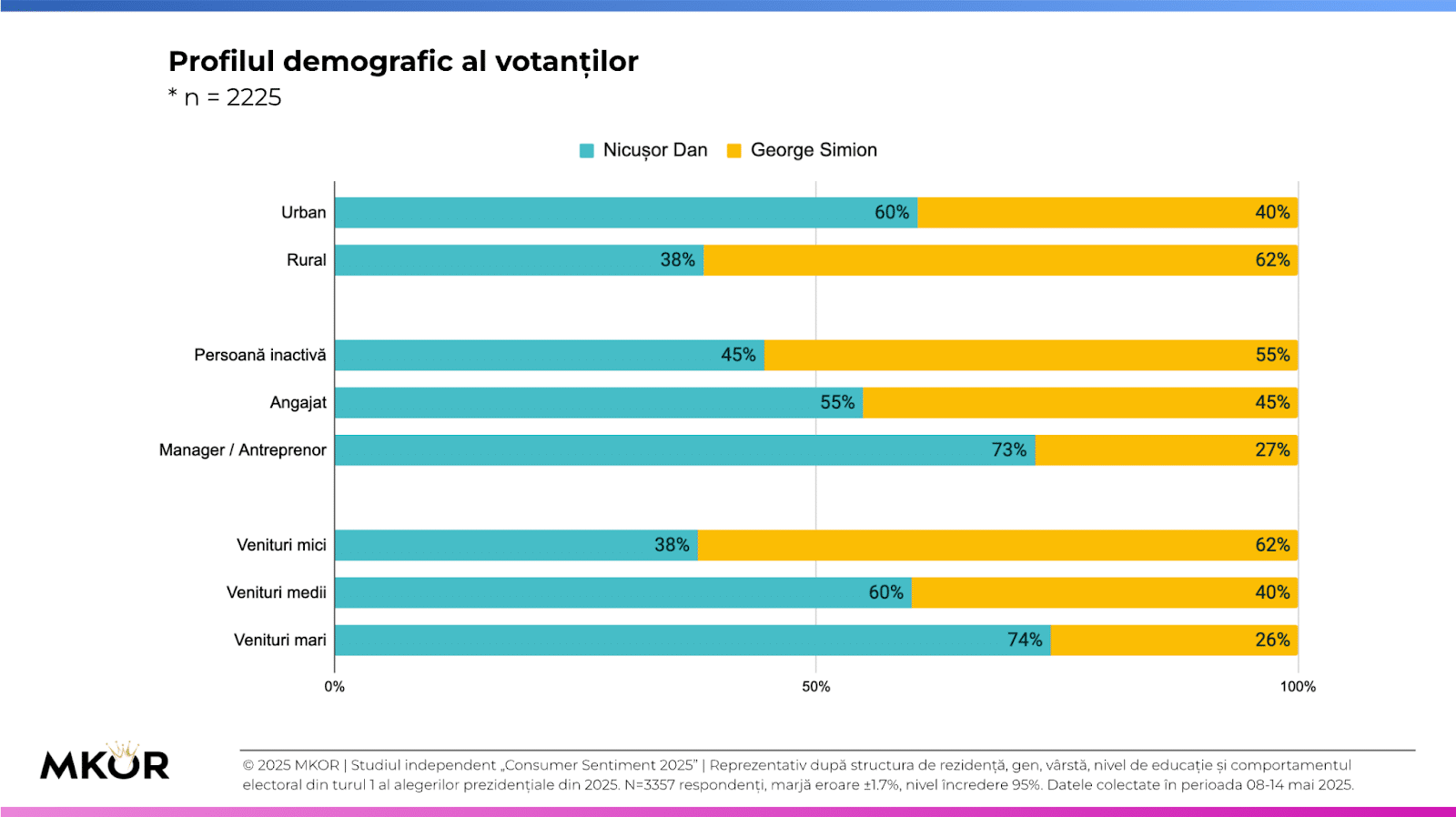
This socio-demographic mapping is not merely an electoral statistic.
It reflects the existence of different life experiences, distinct everyday concerns, and, implicitly, fundamentally opposing expectations of the political class and of the country’s future.
It is a division that transcends politics, reaching into the very social and economic fabric of the nation.
Beyond Who, the Question Is Why
While the socio-demographic profile shows us who voted for each candidate, the fundamental question remains: why?
What reasons, fears, or hopes stood at the basis of choosing between Nicușor Dan and George Simion?
The MKOR study took a qualitative approach to the most important social themes, asking open-ended questions to a significant number of respondents (over 3,300). The answers revealed not just the universe of motivations but also the deep rift within the Romanian nation — two separate areas of meaning shaping the voters of each candidate.
George Simion: The Voice of Revolt and the Call to Roots
For a significant portion of Romanians, voting for George Simion was, above all, a statement. A cry for radical change and an anti-system stance (51.4% of his supporters explicitly invoked this reason).
Expressions such as “I want a fresh start,” “I am tired of 35 years of lies,” or “We need someone who will tell us the truth” dominated the answers, pointing to a profound disillusionment with traditional politics and an acute sense of frustration.
This desire for rupture was often linked to a strong attachment to national identity and values (13.2%). Terms such as “patriot,” “family,” “respect for tradition” were recurrently used and highly valued by this electorate, in contrast with references to modernity, perceived as alien and threatening to their system of values.
Technical competence or administrative experience mattered little (just 5.1% mentioned such aspects); rather, trust was gained through a perception of being “close to the people,” “authentic,” and capable of understanding the “real problems of Romanians.”
Even the most highly rated answers, such as Călin Georgescu’s famous statement “I would trade you for a shepherd”, revealed the emotional charge of the choice — a preference for symbolic gestures over pragmatic solutions.
Nicușor Dan: The Bet on Reason, Integrity, and European Continuity
On the other side, motivation in the first electoral round gravitated toward rational calculation. Nicușor Dan’s supporters emphasized the integrity of the candidate (23.0%), his competence and proven experience (18.1%) — as Mayor of Bucharest and in his civic campaigns — as well as recurring themes such as “He is the only honest one” or “He is Europe-oriented”.
The most frequently used expressions included “a man of the people, but honest” or “the only guarantee for Romania’s place in Europe”.
For many of these voters, choosing Dan was not an act of protest, but a strategic decision: “the lesser evil” (12.4% of his supporters explicitly used this phrase), a rational choice meant to block access to power for someone perceived as anti-system and to maintain Romania’s European trajectory.
Unlike Simion’s supporters, who turned revolt into the main source of legitimacy, Dan’s electorate emphasized trust in institutions, appreciation of competence, and continuity with European values as the pillars of their choice.
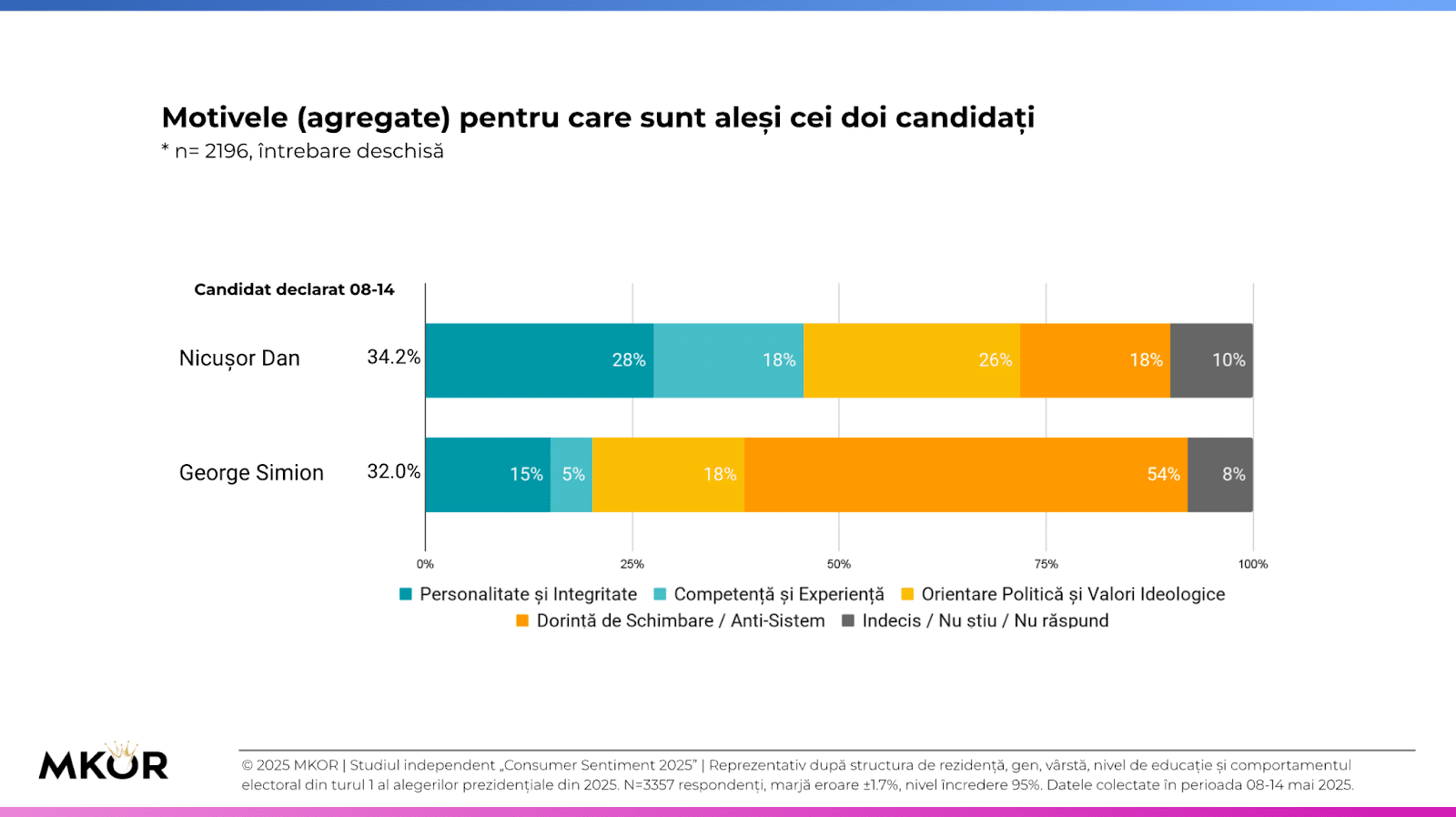
The two Romanias did not just vote differently; they seem to seek fundamentally different things from a leader and from governance itself.
- On one side, a visceral need for change, for reclaiming national dignity and social justice, even at the risk of instability.
- On the other, a desire for normality, administrative competence, and a firm anchoring in European values, even if it means accepting compromise.
The Ideal President vs. The Detested President
If motivations show us why Romanians vote, the traits they seek (or categorically reject) in a president reveal what kind of leader each camp envisions.
The MKOR study explored these expectations, and the results once again outline two almost irreconcilable visions of the role and qualities of a head of state.
What Do Romanians Want from Their President?
At the national level, when asked to choose the three most important qualities for a president, Romanians appear to seek a balance between human connection, intellectual competence, and attachment to national values:
- “Close to the people” (40.8%) – reflecting a need for accessible leaders who understand citizens’ daily concerns.
- “Educated” (39.3%) – competence and solid preparation are essential for a significant portion of the electorate.
- “Patriot” (30.4%) – love of country and defense of national interests remain fundamental criteria. Other top mentions: “Honest” (27.6%), “Decisive” (24.7%), and “Rational” (22.2%), completing the image of an ideal president as a complex and nuanced leader.
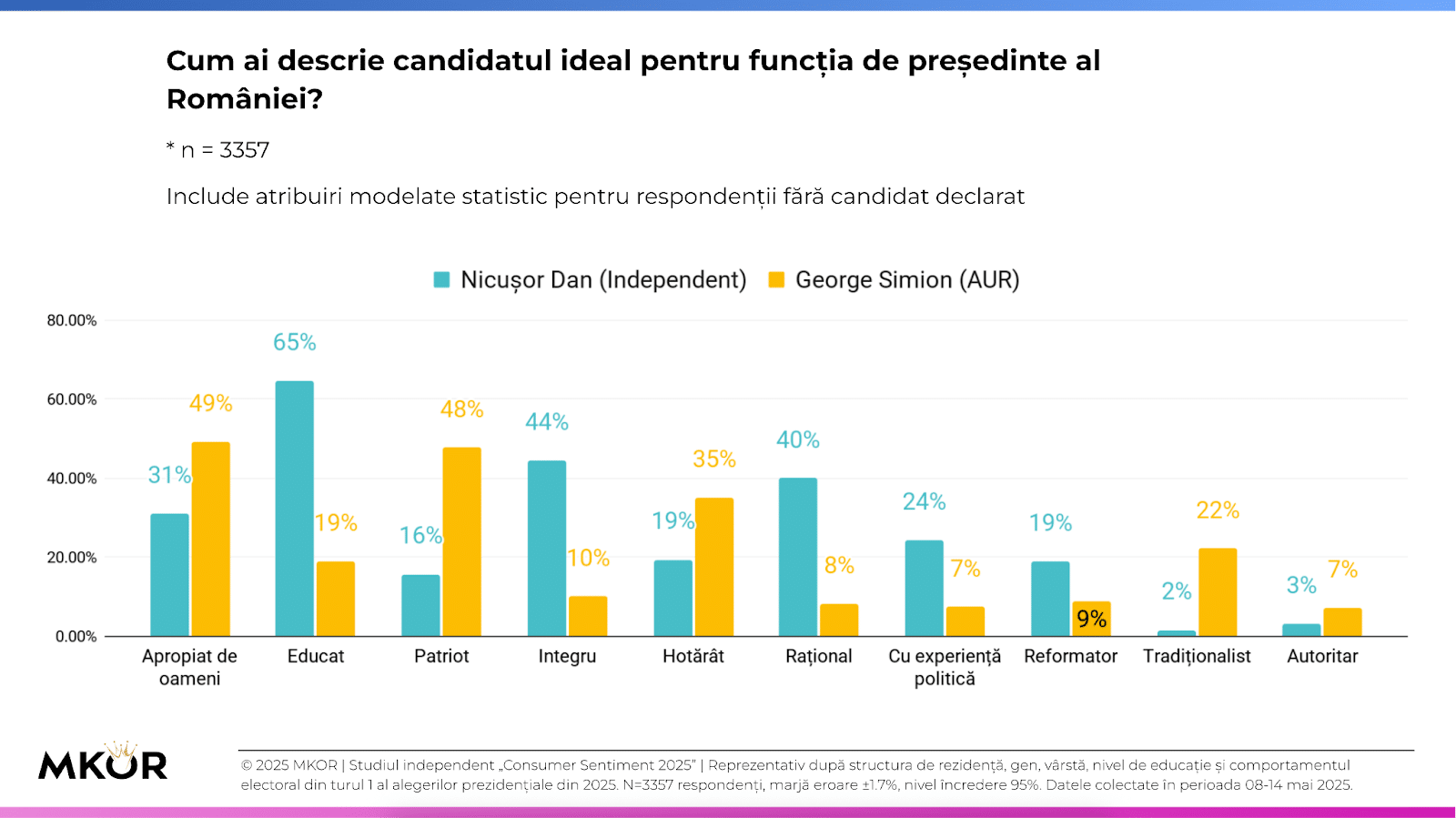
What the Ideal President Looks Like for Romanians
However, when we break down these preferences through the lens of voting for Nicușor Dan or George Simion, the picture splits into two distinct portraits:
Nicușor Dan’s supporters prioritize:
- “Educated” – the dominant trait, mentioned by 65% of them
- “Honest” (44%)
- “Rational” (40%) – reflecting a search for ethical competence and clarity of thought
Qualities such as “Close to the people” or “Patriot” are important, but secondary to expertise and morality.
For this segment, legitimacy stems from knowledge and integrity.
George Simion’s supporters value:
- “Close to the people” (49.2%) and
- “Patriot” (47.7%) – indicating a need for emotional connection and reaffirmation of identity
- “Decisive” (34.9%) – the desire for a leader who acts firmly
Traits such as “Educated” (only 18.8%) or “Honest” (12.1%) fall significantly lower in their hierarchy, while “Traditionalist” (22.1%) becomes relevant.
For these voters, legitimacy comes from perceived authenticity and resonance with popular values.
What Romanians Do Not Tolerate in a President
Equally revealing are the traits that Romanians categorically reject.
The label of “Puppet” (controlled by interest groups) is detested by almost half of the electorate (48%), making it a universal red flag.
Similarly, “Arrogance” (39%) and lack of education (34.3%) are strongly penalized across the voting population.
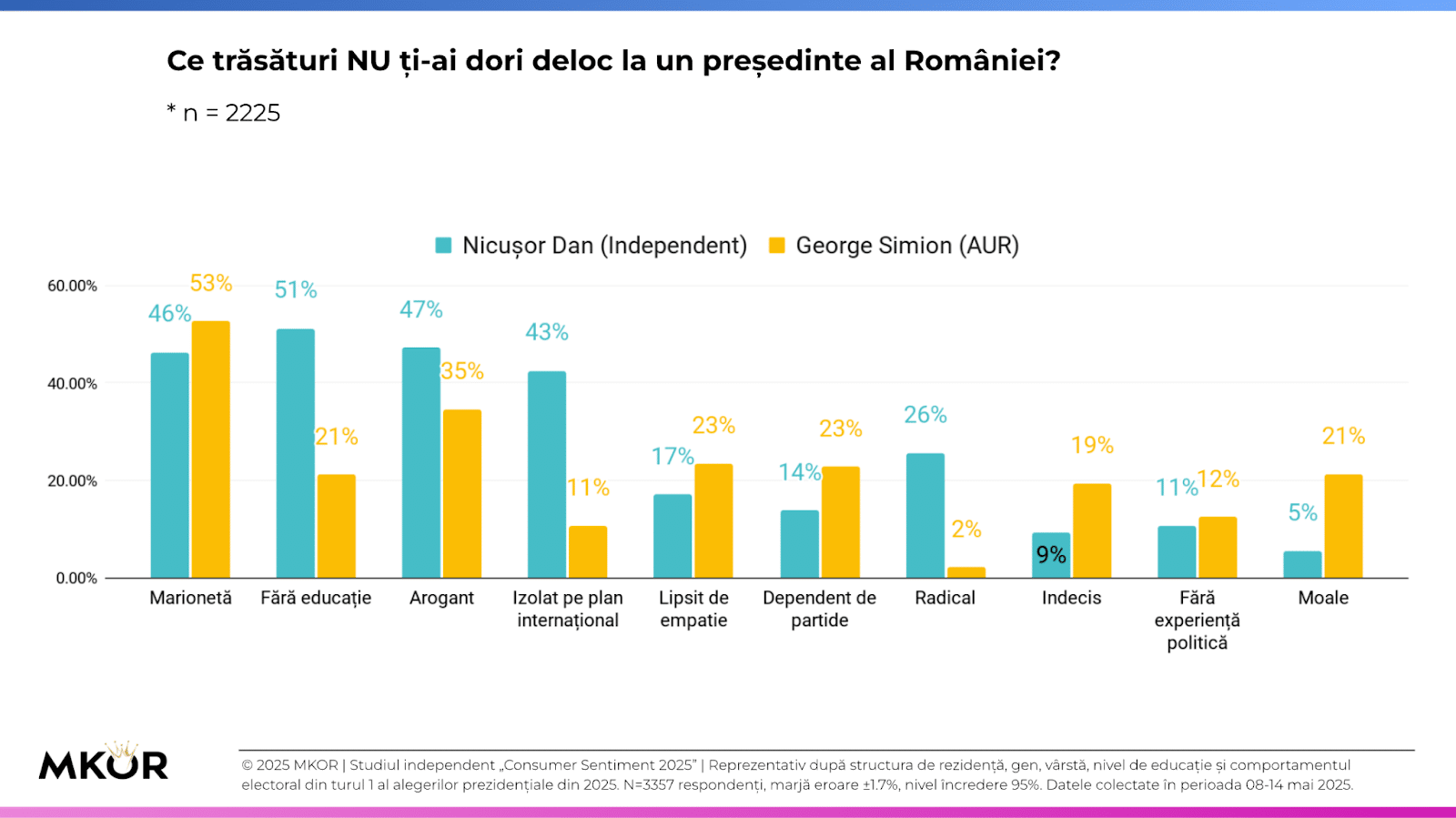
Once again, the emphasis differs:
- Nicușor Dan’s voters are much stricter regarding lack of education (51.2% reject it), arrogance (48%), international isolation (42.5%), and radicalism (25.5%).
- George Simion’s voters, though more lenient on these aspects, react negatively to a president perceived as “Weak” (21.2%) or “Indecisive” (19.3%).
The Leadership Archetype: Pro-Western Reformer vs. The Voice of the Nationalist People
When presented with four generic descriptions of a president, the options aligned almost perfectly with voting preferences:
- Nicușor Dan’s supporters identified more strongly with the “Pro-Western Reformer” (48%) and the “Educated Technocrat, with international reputation” (29%). For them, Romania’s future is anchored in expertise and Western partnerships.
- George Simion’s voters resonated more with the “Voice of the People, with a simple and direct message” (39%) and the “Nationalist Leader, focused on protecting Romanian identity” (41%). For them, popular authenticity and sovereignty are essential.
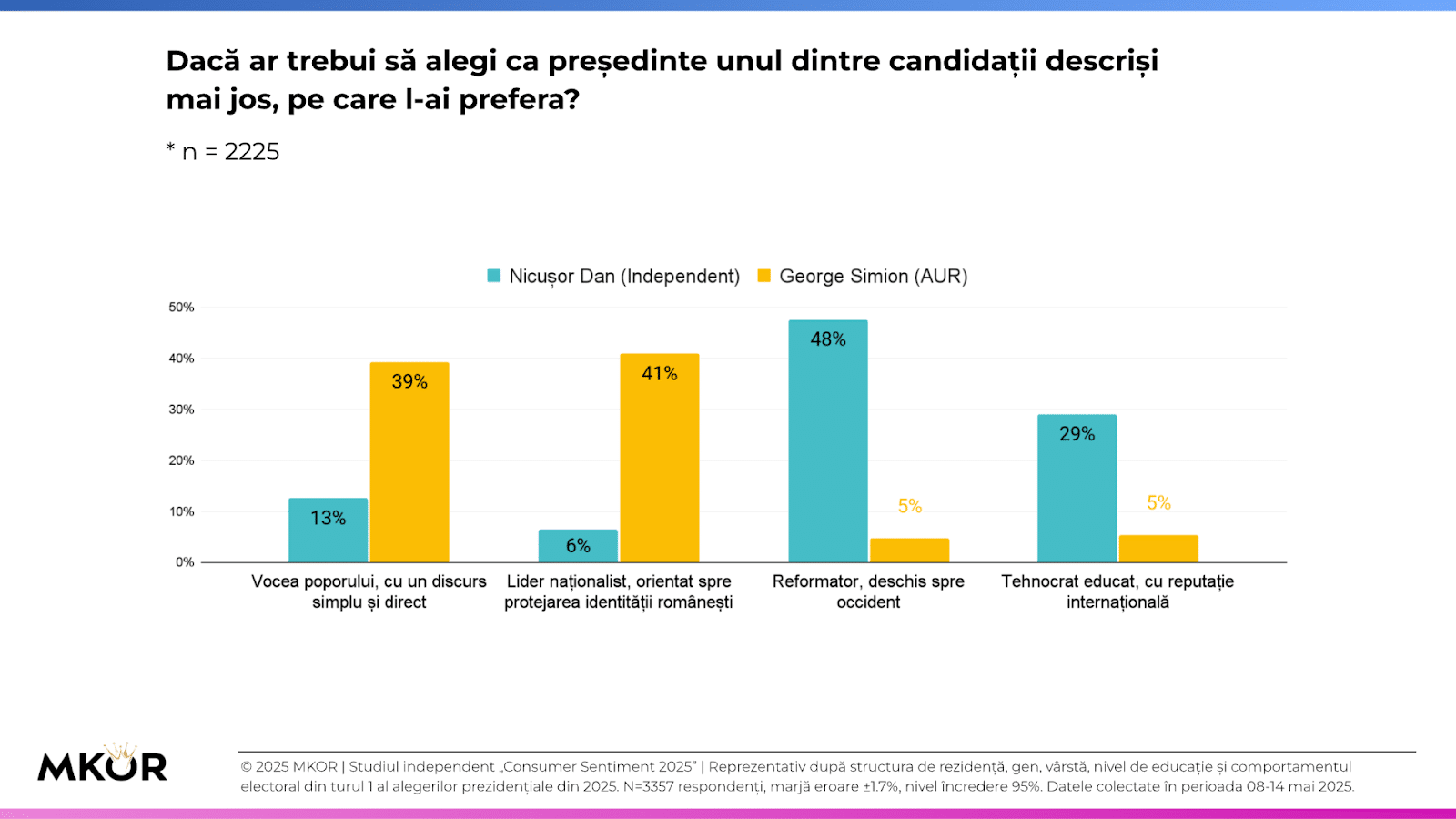
It is evident: the two Romanias not only vote differently, but they also build fundamentally opposing expectations of the one who should represent them.
The divide is not merely one of opinion, but of vision regarding leadership and the role of the president in society.
The Crisis of Trust – When the State Becomes a Stranger to Its Own Citizens
Beyond preferences for a certain candidate or expectations of an ideal leader, MKOR’s study reveals a much deeper issue with long-term implications: an acute crisis of trust in the fundamental institutions of the Romanian state.
This mistrust is not uniform. It manifests differently in the “two Romanias,” both fueling and reflecting the social and political divide.
An Eroded Institutional Landscape: Only Schools and the Church Inspire (Relative) Trust
Looking at the “trust barometer,” the picture is bleak.
The central political institutions — Government, Parliament, and Political Parties — sit at the very bottom of the rankings, managing to convince only a minority of the population to grant them trust.
Only 30–40% of Romanians still show “a lot” or “very much” trust in these institutions that are essential to the functioning of democracy.
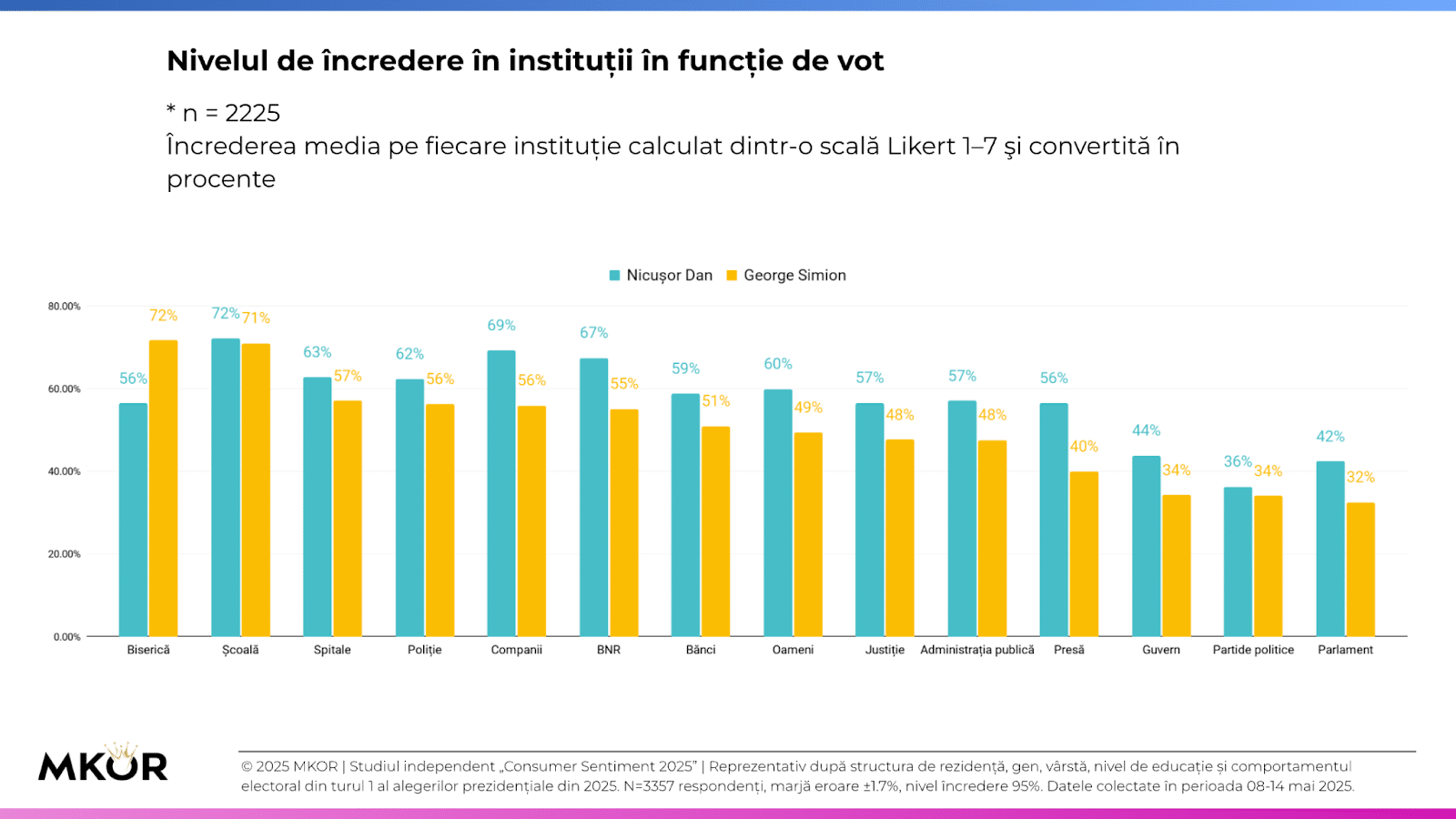
In contrast, schools appear to be the only pillar still generating relative consensus (71–72% trust in both electoral camps).
The Church remains a strong institution, especially among George Simion’s supporters (72% high trust), while in Nicușor Dan’s camp trust in the Church is significantly lower (56%) — though still higher than that accorded to political institutions.
How Supporters of the Two Candidates View Key Institutions
Trust differences between the two electorates become striking when analyzing economic institutions, justice, or the media:
- Economic and Regulatory Institutions (Companies, National Bank, Banks): These are perceived significantly more positively by Nicușor Dan’s supporters (trust higher by 10–15%). This suggests an alignment of his electorate with a development model based on market economy, expertise, and financial stability.
- Justice and the Press: Trust in these institutions is also higher in Nicușor Dan’s camp (by 9–16 percentage points). This may reflect a greater orientation of this electorate toward the values of the rule of law and the role of independent press as a mechanism of social control.
- Perception of the “System”: The generally low level of trust in Government, Parliament, and political parties is even more pronounced among George Simion’s supporters. This underlines that the vote for AUR is, to a large extent, an expression of rejection of a “system” perceived as distant and corrupt.
Profound Implications: A State Without Moral Authority
When the very institutions meant to guarantee democratic functioning and citizens’ well-being enjoy such low levels of trust, the consequences extend far beyond the electoral sphere:
- Difficulty of implementing reforms: Any measure, no matter how necessary, will be met with skepticism and resistance.
- Vulnerability to disinformation and populism: A distrustful public is more susceptible to simplistic narratives and to providential leaders who promise quick solutions outside the institutional framework.
- Erosion of social cohesion: Lack of trust in “the other” (be it politicians, journalists, or experts) deepens polarization and makes constructive dialogue almost impossible.
The message conveyed by the “trust barometer” is alarming:
Romania is facing not only a political crisis, but a structural one — a crisis of legitimacy of the state itself. Without a fundamental reconstruction of the relationship between citizens and institutions, based on transparency, accountability, and tangible results, social cohesion risks unraveling even further. The state urgently needs to regain the trust of its citizens, for only then can we rediscover the bridges that unite us. — Cori Cimpoca
Beyond the Slogans: What Really Troubles Romanians?
Amid the tumult of ideological debates and campaign strategies, the essential is often forgotten: the concrete, day-to-day concerns of Romanians.
The MKOR study explored this dimension, and the results show that, regardless of political affinities, the vast majority of citizens share the same fears related to economic stability and family well-being.
Top Concerns: Taxes, Bills, and Salaries
Regardless of their preferred candidate, when asked what worries them most, Romanians point to pressing issues of economic and social nature:
- The level of taxes (41.9%) – Tax burden is perceived as excessive and a heavy pressure on households.
- Basic expenses (41.3%) – Rising prices for food, utilities, and essential services put increasing strain on families.
- Low salaries (35.8%) – Dissatisfaction with income levels remains one of the most widely shared concerns.
Health remains a recurring worry: the state of the healthcare system (32.5%) and related social services (24.3%), as well as housing insecurity (rent, prices, and access to quality housing, 19.2%).

How Worries Are Nuanced Across the Two Romanias
Although economic issues cut across society, the emphasis differs between the two electorates:
- George Simion’s supporters, largely from rural areas and with lower incomes, are significantly more concerned about taxes and salaries than the national average. For them, the direct impact of economic policies on daily life is likely more visible and pressing.
- Nicușor Dan’s supporters, with an urban profile, higher education, and higher incomes, though equally affected by general economic issues, place additional emphasis on the quality of education and aspects related to mental health. This may reflect that their basic needs are covered to some extent, allowing for a broader set of priorities.
Why Do These Concerns Matter?
These everyday worries form the backdrop against which political decisions are made, even if not always explicitly articulated as voting reasons.
When “the shopping basket and daily expenses” become the key criterion, any political message — whether about sovereignty, European values, integrity, or change — is inevitably filtered through its impact on people’s wallets and personal security.
The candidate able to credibly connect their political vision with concrete solutions to these problems, and convince voters of their feasibility, gains a crucial advantage — potentially decisive.
Ignoring these real concerns in favor of abstract debates or personal attacks risks undermining the credibility of any political actor aspiring to win Romanians’ trust and vote.
A Society at a Crossroads: Challenges and Responsibilities for the Future
The May 2025 presidential elections, with all their tension and emotion, were not merely a one-off democratic exercise. They acted as a powerful revealer, shedding light on a fractured Romania — a society traversed by deep divides that go far beyond political choice.
The MKOR study, through detailed analysis of socio-demographic data, voting motivations, expectations from leaders, and levels of institutional trust, confirms the existence of “two Romanias” that, although sharing the same territory, live in parallel universes.
On one side, urban Romania — educated, connected to European values, concerned with competence, integrity, and a predictable path.
This segment, largely aligned with Nicușor Dan, seeks reform, efficiency, and European anchoring, desiring leaders who can maintain Romania on a stable, competent trajectory.
Their motivations are often pragmatic, based on performance evaluation and on alignment with a set of consolidated democratic principles.
Even when voters choose the “lesser evil,” the decision is a calculated one, meant to preserve a certain status quo considered preferable to radical alternatives.
On the other side, rural Romania and small-town Romania take shape — often more economically vulnerable, with lower levels of education, and profoundly disillusioned with the traditional political class.
This electorate resonated strongly with George Simion’s message, driven by a visceral desire for anti-system change, by a need to reclaim national dignity, and by a search for leaders perceived as “close to the people” and “patriotic.”
For them, the vote is less a political program adhesion and more a protest act, an expression of hope for a reset that might bring better chances for their lives.
This division is not an entirely new phenomenon, but the intensity and clarity with which it emerged in this election raise serious questions about the future of social cohesion in Romania.
The fracture is not simply between left and right, conservative and progressive.
It is a fracture that cuts across the very level of trust, access to education and information, confidence in the state’s institutions, and perhaps most importantly, the perception of what “the common good” means and the correct direction for the country.
The May 2025 elections were, in essence, a symptom of this division, not its cause.
Chronic distrust in political institutions, frustrations accumulated in the face of economic inequalities and lack of perspective, amplified by social media algorithm-driven information bubbles, have created fertile ground for polarization.
Each camp seems to reinforce its own narrative, listening less and less to the arguments of the other.
The responsibility weighing on political leaders, the press, civil society, and every citizen is immense. It is not enough to win elections; the true challenge is to govern for all Romanians, to build bridges where walls have been raised, and to restore a minimum level of mutual trust.
Without conscious efforts for dialogue, empathy, and truly inclusive public policies — policies addressing both material needs and people’s identity and recognition on both sides — this fracture risks deepening, transforming democracy into a perpetual confrontation between irreconcilable frustrations.
Our data does not offer miraculous solutions, but it does point to a clear direction: a deep and honest understanding of these ‘two Romanias’ is the first essential step toward, perhaps one day, being able to speak of a single Romania — united in its diversity.
Cori Cimpoca – MKOR Founder
MKOR on ProTV: Our Independent Study on the 2025 Presidential Elections and Romania’s Divisions – Now Also Published in Academic Research
With a sample of 3,357 respondents and a margin of error of ±1.7%, MKOR’s research was presented on ProTV and published as academic research on Figshare, confirming our pioneering role in electoral analysis.
The study highlights socio-economic divides, the real motivations behind voting, and the impact of the trust crisis, establishing itself as a methodological and qualitative benchmark in academic and journalistic research.
Transparent Methodology – Brief but With All the Cards on the Table
| Collection Period | May 8–14, 2025, 3 consecutive representative waves (8–9, 10–11, 12–14) |
| Method | CAWI (online questionnaire) via MKOR’s own panel |
| Total Sample | N = 3,357 respondents (population 18+ years) |
| Margin of Error | ± 1.7 p.p., at a 95% confidence level |
| Wave Structure | n1 = 698, n2 = 955, n3 = 1704 |
| Representativity | Weighted by gender, age, residence, education, and 1st-round vote (May 4, 2025) by target within Romania; diaspora not included in sample |
| Special Analyses | Modeling indecision & non-responses, daily tracking of voting intention dynamics |
No part of this research was funded or influenced by any political actor. MKOR fully covered the costs to guarantee the independence of the results and the freedom to publish the full raw data in the complete report.
Full access: Download the report “Consumer Sentiment – Presidential Elections Round 2, May 2025” – and discover free additional results.
Have you read everything? Comment / join our newsletter / read our other research posts!
MKOR Consumer Sentiment Study: Principal Reasons for Romanian Concerns in 2023
April 16, 2024
0 Comments8 Minutes





